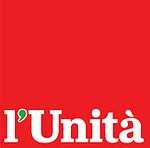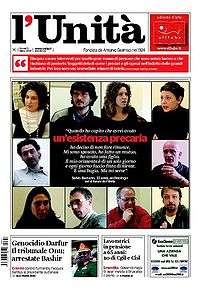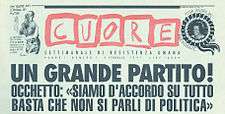L'Unità
 | |
 Front page, 5 March 2009 | |
| Type | Daily newspaper |
|---|---|
| Format | Berliner |
| Owner(s) | Nuova Iniziativa Editoriale S.p.A. |
| Editor | Sergio Staino |
| Founded | 12 February 1924 |
| Political alignment |
Communism (1924–91) Social democracy (1991–present) Parties: PCI (1924–91) PDS (1991–98) DS (1998–2007) PD (2007–present) |
| Headquarters | Rome, Italy |
| Circulation | 20,937 (April 2014) |
| ISSN | 0391-7002 |
| Website | http://www.unita.it/ |

L'Unità [luniˈta] is an Italian left-wing newspaper, founded as official newspaper of the Italian Communist Party. It has been supportive of that party's successor parties, the Democratic Party of the Left, Democrats of the Left, and from October 2007 until its closure, the Democratic Party. The newspaper closed on 31 July 2014.[1] It was restarted on 30 June 2015.
History and profile
L'Unità was founded by Antonio Gramsci[2] on 12 February 1924[3] as the "newspaper of workers and peasants", the official newspaper of Italian Communist Party (PCI).[4] The paper was printed in Milan with a circulation of 20,000 to 30,000. On 8 November 1925, publications were blocked by the Prefect of the city together with Italian Socialist Party's Avanti!. After an assassination attempt on Benito Mussolini (31 October 1926) its publication was completely suppressed. A clandestine edition was resumed on the first day of 1927 with irregular circulation in Milan, Turin, Rome, and in France. Full publication was resumed after the Allied conquest of Rome on 6 June 1944, the new editor-in-chief being Celeste Negarville.
After the liberation from the German occupation, in 1945, new local editions were started in Milan, Genoa and Turin, the latter edited by philosopher Ludovico Geymonat. Elio Vittorini became the editor-in-chief of L'Unità during this period.[5] The newspaper's contributors included Davide Layolo, Luigi Cavallo, Ada Gobetti Cesare Pavese, Italo Calvino, Alfonso Gatto, Aldo Tortorella and Paolo Spriano. In the same year the Festa de l'Unità was launched in most Italian cities.
In 1957 the Genoese, Milanese and Torinese editions were merged into a single edition for northern Italy. The newspaper's editorships were unified in 1962, under Mario Alicata, who was succeeded by Maurizio Ferrara in 1966. In 1974 daily circulation of l'Unità amounted to 239,000 copies, but this number dropped considerably starting from early 1980s, mostly from the competition with the new, left-oriented, La Repubblica: the 100 million copies sold in 1981 decreased to 60 million, in 1982. In the subsequent year a document published by the newspaper, which accused the Christian Democratic minister Vincenzo Scotti of being a collaborator of the Camorra leader Raffaele Cutolo, which proved to be a false. The editor-in-chief Claudio Petruccioli resigned and was replaced by Emanuele Macaluso. Massimo D'Alema, the future Prime Minister of Italy, was managing-director until July 1990.
From 1989 to 1990 the newspaper was accompanied by a satirical weekly magazine, Cuore, directed by Michele Serra. In 1991 the title changed from Journal of the Italian Communist Party to Journal founded by Antonio Gramsci. From 1992 to 1996 director was Walter Veltroni, who started periodically accompanying the newspaper with free gifts such as books and videocassettes.
The newspaper ceased publication for eight months from 28 July 2000 to 28 March 2001 because of financial troubles. Since then it was published by Baldini & Castoldi, a company not linked to the Democrats of the Left or Democratic Party. Its political position, however, continued to be strongly tied to the Democratic Party.[3]
On May 2008 Tiscali founder and Sardinia President Renato Soru finalized a deal to become the new newspaper owner.[6] One of the first moves made by the new property was the appointment of former La Repubblica journalist Concita De Gregorio as new editor-in-chief in August 2008,[3] replacing Antonio Padellaro in the post.[7] On 7 May 2012 the paper began to be published in Berliner format.[8]
l'Unita again suspended publication on 31 July 2014.[1][9][10] A meeting of shareholders was unable to decide how to keep the newspaper financially viable; debts amounted to €30 million.[11]
Circulation
The 1988 circulation of l'Unita was 300,000 copies.[12] In 1991 the paper had a circulation of circa 156,000 copies. Next year its circulation was 124,000 copies.[13] In 1997 it was the tenth best-selling Italian newspaper with a circulation of 82,078 copies.[14]
The circulation of the paper was 49,536 copies in 2008 and 53,221 copies in 2009.[15] It fell to 44,450 copies in 2010.[15] In April 2014 the paper had a circulation of 20,937 copies.[16]
References
- 1 2 "Addio a l'Unità dal 1° agosto. I giornalisti: ci hanno uccisi". E Polis. 30 July 2014. p. 2.
- ↑ "Austerity threatens Europe's Left press". Revolting Europe. 12 January 2012. Retrieved 1 July 2015.
- 1 2 3 Anna Momigliano (16 September 2008). "In Italy, Female Editor Signals Women's Rise". The Christian Science Monitor. Retrieved 24 November 2014. – via Questia (subscription required)
- ↑ Angela Vettese (2012). "Italy in the Sixties: A Historical Glance". In Bernhard Mendes Bürgi. Arte Povera. The Great Awakening (PDF). Hatje Cantz. ISBN 978-3-7757-3357-1. Retrieved 19 April 2015.
- ↑ Herbert Lottman (15 November 1998). The Left Bank: Writers, Artists, and Politics from the Popular Front to the Cold War. University of Chicago Press. p. 252. ISBN 978-0-226-49368-8. Retrieved 28 December 2014.
- ↑ "Editoria, Soru compra l'Unità. Una fondazione gestirà il giornale". La Repubblica (in Italian). 20 May 2008. Retrieved 28 August 2008.
- ↑ "Concita De Gregorio alla guida dell'Unità". Corriere della Sera (in Italian). 22 August 2008. Retrieved 26 August 2008.
- ↑ "Redesign newspaper: L'unita, Italy". Behance. Retrieved 9 February 2015.
- ↑ Hanno ucciso l'Unità, l'Unità, 30 July 2014
- ↑ "Italian Communist party paper folds after 90 years". The Local. 2 August 2014. Retrieved 25 November 2014.
- ↑ Lizzy Davies "Italian newspaper stops publication as shareholders fail to agree rescue deal", The Guardian, 30 July 2014
- ↑ Peter Humphreys (1996). Mass Media and Media Policy in Western Europe. Manchester University Press. p. 90. Retrieved 29 October 2014.
- ↑ David Forgacs; Robert Lumley, eds. (1996). Italian Cultural Studies:An Introduction. Oxford, England: Oxford University Press. Retrieved 28 December 2014. – via Questia (subscription required)
- ↑ Jose L. Alvarez; Carmelo Mazza; Jordi Mur (October 1999). "The management publishing industry in Europe" (Occasional Paper No:99/4). University of Navarra. Retrieved 27 April 2015.
- 1 2 "National Newspapers". International Federation of Audit Bureaux of Circulations. Retrieved 5 March 2015.
- ↑ Data (April 2014). Accertamenti Diffusione Stampa.
| Wikimedia Commons has media related to L’Unità. |